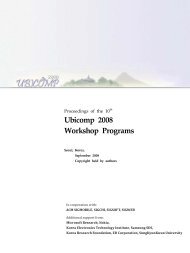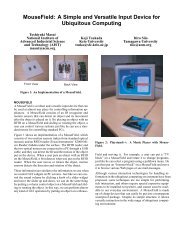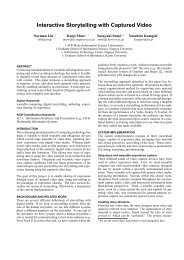Health Monitoring System in the Bedroom using ... - UbiComp
Health Monitoring System in the Bedroom using ... - UbiComp
Health Monitoring System in the Bedroom using ... - UbiComp
You also want an ePaper? Increase the reach of your titles
YUMPU automatically turns print PDFs into web optimized ePapers that Google loves.
<strong>Health</strong> <strong>Monitor<strong>in</strong>g</strong> <strong>System</strong> <strong>in</strong> <strong>the</strong> <strong>Bedroom</strong> us<strong>in</strong>gUbiquitous TechnologyJong M<strong>in</strong> ChoiInterdiscipl<strong>in</strong>ary Program <strong>in</strong> BiomedicalEng<strong>in</strong>eer<strong>in</strong>gSeoul National University, Seoul, Korealeson@bmsil.snu.ac.kr82-2-740-8585Kwang Suk ParkDepartment of Biomedical Eng<strong>in</strong>eer<strong>in</strong>g, College ofMedic<strong>in</strong>eSeoul National University, Seoul, Koreakspark@bmsil.snu.ac.kr82-2-760-3135ABSTRACTAdvances <strong>in</strong> <strong>in</strong>formation technology have enabledubiquitous health monitor<strong>in</strong>g at home, which is particularlyuseful for patients, who have to live alone. We havefocused on <strong>the</strong> automatic and unobtrusive measurement ofbiomedical signals and activities of patients. We haveconstructed wireless communication networks <strong>in</strong> order totransfer data. The networks consist of Bluetooth andWireless Local Area Network (WLAN). In this paper, wepresent <strong>the</strong> concept of a ubiquitous-<strong>Bedroom</strong> (u-<strong>Bedroom</strong>)which is a part of a ubiquitous-House (u-House) and wepresent our systems for ubiquitous health monitor<strong>in</strong>g.INTRODUCTIONUbiquitous health monitor<strong>in</strong>g allows biomedical signals tobe measured without <strong>the</strong> <strong>in</strong>dividual’s awareness. Forsuccessful ubiquitous monitor<strong>in</strong>g <strong>the</strong> biomedical signalsneed to be measured unobtrusively and <strong>the</strong> data need to betransferred us<strong>in</strong>g a wireless communication system.Biomedical signal measurement is very important <strong>in</strong> <strong>the</strong>field of telemedic<strong>in</strong>e and health monitor<strong>in</strong>g because it is <strong>the</strong>precursor of analysis and diagnosis. In previous studiesunobtrusive biomedical signal measurement was not a ma<strong>in</strong>issue. M. Ishijima[1] presented a method to measureElectrocardiogram (ECG) <strong>in</strong> bed without any body surfaceelectrodes. Instead of body surface electrodes, conductivetextile electrodes were used <strong>in</strong> order to measure ECG signal.T. Tamura et al.[2] showed that it was possible to obta<strong>in</strong>ECG signal <strong>in</strong> <strong>the</strong> bathtub only us<strong>in</strong>g water.Bluetooth communication technology has many advantagesfor <strong>the</strong> field of telemedic<strong>in</strong>e. A lot of data has to betransferred and processed because biomedical signals,activities and environmental parameters are always be<strong>in</strong>gmonitored. Wireless Local Area Network (WLAN) isneeded <strong>in</strong> association with Bluetooth communicationnetwork. Us<strong>in</strong>g Bluetooth technology and WLAN, anyproblems regard<strong>in</strong>g bandwidth and speed can be solved.In this paper, we describe ubiquitous health monitor<strong>in</strong>gsystem <strong>in</strong> <strong>the</strong> bedroom. We have focused on <strong>the</strong>unobtrusive biomedical signal measurement and wirelessdata transfer us<strong>in</strong>g Bluetooth technology and WLAN. Thesetwo ma<strong>in</strong> technologies have enabled ubiquitous healthmonitor<strong>in</strong>g without patient’s awareness.MATERIALS AND METHODSThe ubiquitous-House (u-House) has a toilet, kitchen, liv<strong>in</strong>groom, and three bedrooms. Sensors are <strong>in</strong>stalled <strong>in</strong> eachlocation. In <strong>the</strong> bedroom, <strong>the</strong>re are five sensors whichmeasure biomedical signals, activities and environmentalparameters.Fig. 1 Diagram of <strong>the</strong> ubiquitous bedroom and location ofsensorsA. Unobtrusive Biomedical Signal MeasurementIn <strong>the</strong> bedroom, three biomedical signals can be measuredfrom <strong>the</strong> bed.1) ECG signal measurement on bedAn ECG signal can be obta<strong>in</strong>ed from <strong>the</strong> patient <strong>in</strong> bedus<strong>in</strong>g a conductive sheet. Whenever <strong>the</strong> patient lies on bedat night, ECG signals are measured by a conductive textileelectrode attached to <strong>the</strong> bed sheet. In order to process <strong>the</strong>ECG signal an amplifier has been developed. This bioamplifierhas several filters, namely a low-pass, notch, andhigh-pass filter. Such filters can remove noise and it ispossible to obta<strong>in</strong> a clear ECG signal comparable to <strong>the</strong>common Ag-AgCl direct contact electrode.2) Body movement dur<strong>in</strong>g sleepBedLoadcell Conductive Sheet Snor<strong>in</strong>g SensorMagnetic SwitchTemperature SensorDoor1
Dur<strong>in</strong>g sleep, <strong>the</strong> patient moves around. The movement ofpatients can reflect <strong>the</strong>ir health. To analyze <strong>the</strong>ir health,movement needs to be measured. The four compressiontype load cells[3] which have been attached to <strong>the</strong> legs of<strong>the</strong> bed can measure <strong>the</strong>se movements.3) Snor<strong>in</strong>g detection dur<strong>in</strong>g sleepThe number of patients who suffer from severe snor<strong>in</strong>g hasbeen <strong>in</strong>creas<strong>in</strong>g. It is necessary to detect snor<strong>in</strong>g and assesshow long he/she snores dur<strong>in</strong>g sleep. Snor<strong>in</strong>g detectionequipment uses an electret condenser microphone andRMS-to-DC converter.B. Activities and Environmental Parameters <strong>Monitor<strong>in</strong>g</strong>Activity monitor<strong>in</strong>g can be beneficial for elderly peoplewho live alone at home. If a medical doctor has ordered apatient to do exercise such as wander<strong>in</strong>g around at home, itis possible to monitor whe<strong>the</strong>r he/she does exercise or not.Attach<strong>in</strong>g a magnetic switch to a door makes it easy to f<strong>in</strong>dout whe<strong>the</strong>r <strong>the</strong> door has been opened or not.There are several parameters regard<strong>in</strong>g <strong>the</strong> environmentsuch as temperature, humidity, noise, and illum<strong>in</strong>ation. It isimportant to monitor <strong>the</strong>se parameters cont<strong>in</strong>uously for <strong>the</strong>patients. It is possible to measure room temperature us<strong>in</strong>g a<strong>the</strong>rmistor which is a k<strong>in</strong>d of variable resistor. Theresistance of <strong>the</strong>rmistor decreases as <strong>the</strong> <strong>in</strong>crease oftemperature.C. NetworksThe Wireless communication has enabled unobtrusivehealth monitor<strong>in</strong>g. Lots of wires <strong>in</strong> <strong>the</strong> bedroom can annoypatients. A Bluetooth network has been used for <strong>the</strong>purpose of transferr<strong>in</strong>g data from <strong>the</strong> sensor to <strong>the</strong>Bluetooth access po<strong>in</strong>t[4] and a WLAN has also been usedfrom <strong>the</strong> Bluetooth server to <strong>the</strong> Home server. For <strong>the</strong>WLAN, a Personal Digital Assistant (PDA) has been<strong>in</strong>stalled <strong>in</strong> each bedroom.MagneticSwitchRoomECG onBedSnor<strong>in</strong>gSensorD. Data Process<strong>in</strong>g UnitBT APPDA with WLANWeightFig. 2 Diagram of <strong>the</strong> data transferMa<strong>in</strong>ServerFor data process<strong>in</strong>g and transfer, a small data process<strong>in</strong>gunit has been developed. It consists of three parts – power,microcontroller and Bluetooth module.This process<strong>in</strong>g unit can do Analog-Digital Conversionwith a 10bit resolution. Analog signals can be digitized andtransferred to <strong>the</strong> Home server which collects and analyzes<strong>the</strong> data. In our successive studies, this process<strong>in</strong>g andtransfer unit will be used and modified.6VACAdaptorExternalPower5VDC-DCConverterBT ModuleAVR4433ADC <strong>in</strong>puts(2ch)Fig. 3 Diagram of <strong>the</strong> data process<strong>in</strong>g unitDISCUSSION AND CONCLUSIONSThere are a lot of sensors which can measure biomedicalsignals, activities and environmental parametersunobtrusively. Among <strong>the</strong>m, just a few sensors were used<strong>in</strong> our <strong>in</strong>stallation. In <strong>the</strong> future, o<strong>the</strong>r useful sensors will beused <strong>in</strong> experiments. For body fat measurement, a methodwhich can estimate bio-impedance will be applied. Inaddition, <strong>in</strong>frared sensors will be used for movementdetection and humidity sensors also will be used forhumidity monitor<strong>in</strong>g. O<strong>the</strong>r sensors can be easily<strong>in</strong>corporated <strong>in</strong>to our system because we have alreadydeveloped <strong>the</strong> small-size data process<strong>in</strong>g and transfer unit.We have not done sufficient experiments on elderly people.In this paper, <strong>the</strong> experiments should be consideredprelim<strong>in</strong>ary and more data is needed.Unobtrusive biomedical signal measurement and datatransfer via wireless communication has enabled ubiquitoushealth monitor<strong>in</strong>g. Just sleep<strong>in</strong>g on bed and walk<strong>in</strong>g around<strong>the</strong> room allows measurement of some biomedical signals.In addition, activities of patients and environmentalparameters such as temperature can be recorded withoutany notice of <strong>the</strong> patients.REFERENCES1. M. Ishijima, <strong>Monitor<strong>in</strong>g</strong> Electrocardiogram <strong>in</strong> bedwithout body surface electrode, IEEE Transactions onBiomedical Eng<strong>in</strong>eer<strong>in</strong>g, 1993;40(6):593-5942. T. Tamura, T. Togawa, M. Ogawa, M. Yoda. Fullyautomated health monitor<strong>in</strong>g system <strong>in</strong> <strong>the</strong> home,Medical Eng<strong>in</strong>eer<strong>in</strong>g and Physics, 1998;20:573-5793. CAS Co. LTD http://www.cas.co.kr4. Initium Co. LTD. http://www.<strong>in</strong>itium.co.krProgramDownloadGND3cm2






